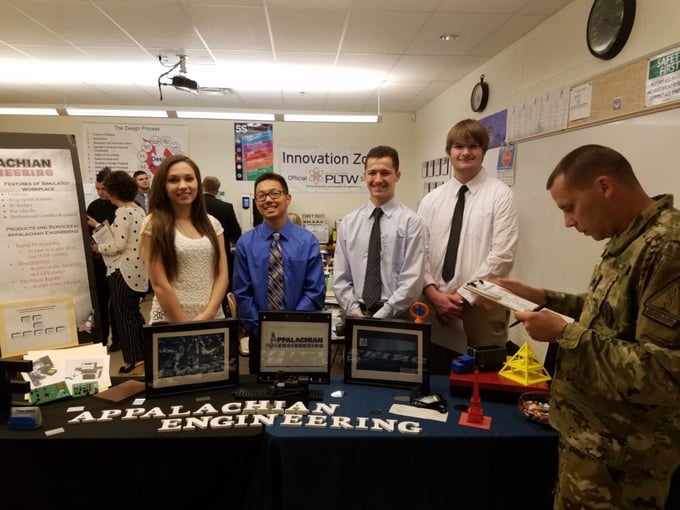Thomas Bane teaches Introduction to Engineering Design (IED), Principles of Engineering (POE), Aerospace Engineering (AE), Digital Electronics (DE), Computer Integrated Manufacturing (CIM), Civil Engineering and Architecture (CEA), and Engineering Design and Development (EDD) at Mingo Central High School in Delbarton, West Virginia. Thomas is Autodesk Certified in Inventor, AutoCAD, and Revit.
The Pre-Engineering program at Mingo Central has grown so much since its implementation five years ago. We started with 25 students and now have over 75 students. Many of them now attend college to pursue a career in engineering. Others took the classes just because they enjoyed them so much. Teaching these courses using the problem-based and project-based teaching techniques has been very effective, resulting in students learning more deeply and creatively.
Our PLTW Engineering program is structured like a business, called Appalachian Engineering. This is a result of implementing the Simulated Workplace initiative with the West Virginia Department of Education. Students hold various rotating leadership roles: project manager, floor manager, safety manager, attendance officer, payroll director, etc. They learn the responsibilities of these roles and how to function in a business environment while they learn the skills and concepts in the PLTW curriculum. They even get simulated paychecks each week. They can pay “$100” to have their style of music played during class, since 1980s music is not always their genre of music. This year, we will be using QuickBooks so their paychecks will come with taxation. They will have to save their money so they can buy a ticket to the end-of-the-year company picnic.
Students say there is a stark difference in the way the engineering classes are taught compared to their other classes. They also indicate it is fun, which makes them want to learn. In fact, they find they learn more than they think they are learning and often discover cross-curricular concepts that align with their other classes.
This is evident when students present their capstone projects before a team of evaluators. During the inspection, the students describe their project goals, the problems they encountered, and how they dealt with those problems. One student said, “I didn’t realize how much I knew until I had to discuss my project with a total stranger.” Through the capstone projects, especially, the students really learn how to work in teams. They learn that they have to work together to meet the project goals and objectives, or they could have egg on their faces.
This being our fifth year offering PLTW courses and our second year offering the Engineering Design and Development (EDD) course, our students are developing increasingly creative solutions to their particular problems. One group of three high schoolers were concerned about how to minimize or eliminate the number of deaths of children or pets locked in hot cars. Their solution was mechanical, although they said it needed an electrical component to further complete their working prototype. Incidentally, another school had a team of girls that developed the electrical component for the exact same project in their PLTW EDD class. There was no communication between our schools or these students, but wouldn’t it be interesting if these two groups put their heads together to develop a comprehensive solution? These young men were encouraged to pursue a patent for their idea. Needless to say, they were shocked at that recommendation. During the evaluation of my students’ projects, evaluators noted that there has been a steady and pronounced increase in the quality of projects the students have developed, and also, the level of critical-thinking skills observed in our students has greatly increased.
In addition, several parents have declared that their children have been deeply impacted by the Pre-Engineering program. For some students, the experience in PLTW courses helped them confirm their decisions to pursue their respective careers in engineering. Others said they noticed a strong desire in their children to want to go to school, just to be part of the PLTW classes. One parent said she always brags about the PLTW Engineering program at Mingo Central to the Mingo County Superintendent of Schools. She said it has had a lasting positive impact on her son.
Some students opt to enroll in the local community college for electrical engineering. All of them say that they already knew much of the material covered in their introductory class. They felt they could succeed in college; many of our students otherwise lack the confidence to perform well in a postsecondary school. Another student who is attending a university to study chemical engineering said one of his first classes was almost entirely a recap of what he already learned in his PLTW classes. Again, the level of preparedness the PLTW Engineering program provides our students is amazing. College professors say they can tell which students have had PLTW training compared to those who have not. The PLTW Engineering program has had a tremendous impact in this impoverished region of the state. We hope it will continue for many years to come.
PLTW’s blog is intended to serve as a forum for ideas and perspectives from across our network. The opinions expressed are those of this guest author.

